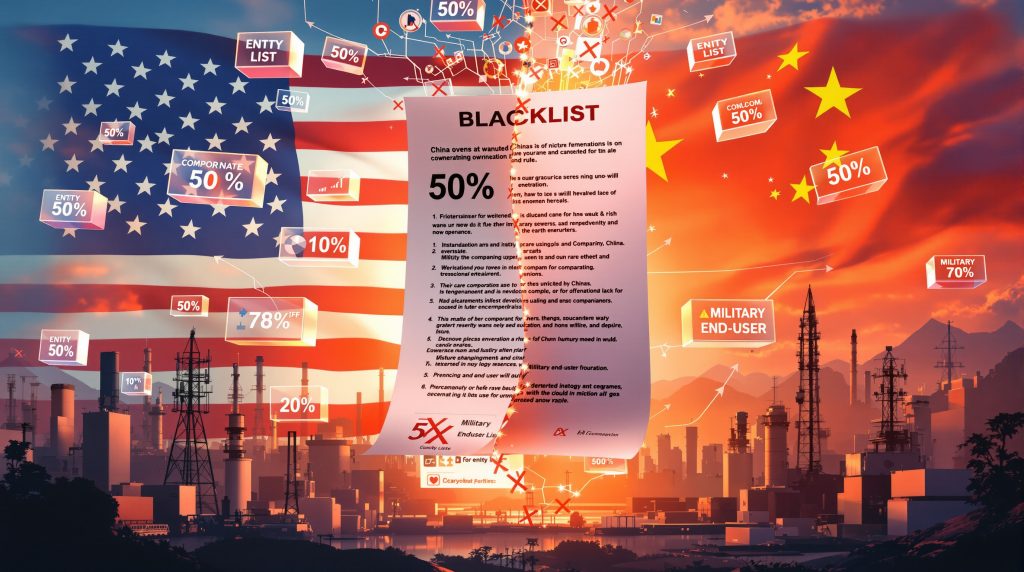Understanding America's Enhanced Export Control Framework
The US-China trade blacklist expansion has fundamentally transformed international commerce through enhanced restrictions targeting corporate ownership structures. Furthermore, the Bureau of Industry and Security operates two primary trade restriction mechanisms that have reshaped global trade relationships. The Entity List and Military End-User List represent sophisticated regulatory tools designed to prevent technology transfers that could compromise national security interests.
These lists have evolved from targeted sanctions affecting hundreds of companies into comprehensive networks capturing thousands of entities worldwide. The US‑China trade war impacts continue to influence policy decisions across multiple sectors.
The Entity List operates under the Export Administration Regulations, specifically Part 744, Supplement No. 4 of Title 15 CFR. This framework requires US exporters to obtain specific licenses before conducting business with designated entities. Consequently, the Military End-User List, governed by 15 CFR § 744.21, targets organizations supporting military applications or dual-use technologies that could enhance foreign defense capabilities.
Historical context reveals the Entity List's establishment in 1997 under the Export Administration Act, initially focusing on proliferation concerns and regional conflicts. Over nearly three decades, these restrictions have expanded to address emerging technological threats, particularly in areas like artificial intelligence, quantum computing, and advanced semiconductor manufacturing.
The 50% Ownership Rule: A Game-Changing Policy Shift
The September 2024 rule modification introduced automatic subsidiary inclusion for companies with 50% or greater ownership by listed entities. This technical adjustment eliminated a significant enforcement gap that allowed sanctioned organizations to continue accessing US technology through affiliated companies.
According to Federal Register documentation from September 27, 2024, the ownership calculation encompasses direct and indirect control structures, including equity ownership, voting rights, and board representation. In addition, the automatic application process means subsidiary companies no longer require separate listing notifications once their parent entities meet the ownership threshold.
This mechanism addresses complex corporate structures involving multiple ownership tiers and holding company arrangements. Previously, companies could circumvent restrictions by establishing majority-owned subsidiaries that operated independently from explicitly listed parent organizations. However, the 50% rule closes this loophole by extending restrictions through entire corporate networks.
Strategic Motivations Behind the Policy Enhancement
National security concerns have driven the expansion of export controls beyond traditional military applications into civilian technology sectors. The policy targets technological capabilities that could enhance foreign military modernisation, intelligence gathering, or surveillance programs that threaten democratic institutions.
Technology transfer prevention objectives focus on critical areas including advanced semiconductors, artificial intelligence systems, and quantum computing research. These technologies possess dual-use applications that could strengthen adversaries' capabilities in cyber warfare, missile guidance systems, or electronic surveillance programs.
The enhanced framework aligns with broader strategic competition policies aimed at maintaining technological leadership in critical industries. For instance, the Trump exec order on critical minerals reflects similar strategic priorities. This approach reflects recognition that economic security and national security have become increasingly interconnected in the modern global economy.
Targeting Corporate Structure Circumvention
Sanctioned entities had developed sophisticated evasion tactics involving shell company networks and ownership obfuscation strategies. Common circumvention methods included establishing subsidiaries with ownership percentages just below previous thresholds, creating joint ventures with non-listed partners, and utilising complex holding company structures.
The 50% ownership rule eliminates the need for individual subsidiary investigations and listings. This streamlined approach prevents sanctioned entities from accessing restricted technologies through corporate restructuring or ownership manipulation tactics that previously exploited regulatory gaps.
Scale of the New Restrictions
Arthur Kroeber of Gavekal Dragonomics estimated that the rule change would expand affected companies by thousands or tens of thousands beyond the approximately 600 Chinese entities previously listed. This exponential increase reflects the comprehensive nature of modern corporate ownership structures, where single parent companies often control dozens or hundreds of subsidiary organisations.
The geographic distribution of newly affected companies extends far beyond China, encompassing entities in Hong Kong, Singapore, and other Asia-Pacific locations with Chinese business relationships. European and American subsidiaries of Chinese parent companies also fall under the expanded restrictions, creating compliance challenges for multinational corporations.
Compliance Burden Multiplication
Enhanced due diligence requirements now mandate comprehensive ownership structure investigations for all potential customers and business partners. US exporters must verify parent company relationships through corporate registries, public disclosures, and beneficial ownership databases before conducting transactions.
Documentation and verification processes have become significantly more complex, requiring:
- Corporate structure analysis through multiple ownership tiers
- Regular monitoring of ownership changes and corporate restructuring
- Legal documentation proving compliance with subsidiary screening requirements
- Transaction approval processes that can extend timelines by weeks or months
Supply chain screening systems require comprehensive updates to identify subsidiary relationships and ownership connections that trigger restriction requirements. This technological infrastructure investment represents a substantial cost burden for companies engaged in international trade.
Technology Sector Ramifications
The semiconductor industry faces the most comprehensive restrictions under the expanded framework. Advanced chip manufacturing equipment, specialised design tools, and cutting-edge lithography systems are subject to strict licensing requirements that effectively prevent technology transfer to restricted entities and their subsidiaries.
Artificial intelligence and machine learning technologies represent another priority area for export controls. Restrictions encompass specialised processors designed for AI training, advanced algorithms with military applications, and quantum computing research that could enhance cryptographic capabilities or surveillance systems.
Furthermore, telecommunications equipment restrictions focus on 5G infrastructure components, network security technologies, and communication systems that could facilitate intelligence gathering or cyber warfare capabilities. These controls extend to subsidiary companies involved in equipment manufacturing, software development, or network deployment services.
Critical Materials and Manufacturing
Rare earth element processing technologies and advanced manufacturing equipment face significant restrictions under the expanded framework. These controls target both the materials themselves and the specialised equipment required for processing, refining, and incorporating these elements into high-technology applications.
The US mineral production order exemplifies government priorities in securing critical supply chains. Advanced manufacturing equipment restrictions include:
- Precision machine tools capable of producing military-grade components
- Lithography systems for semiconductor manufacturing
- Specialised production technologies for aerospace applications
- Quality control and testing equipment with dual-use capabilities
The dual-use nature of these technologies creates compliance challenges, as civilian applications often utilise identical equipment and processes required for military manufacturing. This overlap necessitates careful classification and licensing procedures for international transactions.
Beijing's Retaliatory Measures
China expanded its rare earth export controls in early October 2024, approximately two weeks following the US rule change implementation. The timing suggests a direct retaliatory response designed to leverage China's dominant position in critical material supply chains.
Beijing's countermeasures impose licensing requirements on specific rare earth elements and processing technologies, extending controls to overseas entities and re-exports in an attempt to match the extraterritorial reach of US export controls. According to Reuters analysis of export restrictions, the Ministry of Commerce and General Administration of Customs jointly administer this expanded licensing system.
Critical materials targeted by Chinese export controls include strategic minerals essential for defence applications, renewable energy technologies, and advanced manufacturing processes.
Diplomatic and Economic Countermeasures
China has emphasised developing indigenous supply chains to reduce dependency on Western technology and materials. This strategy encompasses partnerships with Russia, Middle Eastern nations, and Global South countries to create alternative trading networks that bypass US-controlled systems.
Alternative supplier development initiatives focus on:
- Technology transfer agreements with non-Western partners
- Investment programmes in friendly nations' industrial capabilities
- Research collaboration networks excluding US and allied institutions
- Financial mechanisms that avoid US dollar-denominated transactions
These diplomatic efforts represent long-term structural changes in global trade relationships rather than short-term tactical responses to specific policy measures.
Immediate Disruption Patterns
Manufacturing delays have become widespread as companies struggle to determine whether suppliers or customers fall under the expanded ownership restrictions. Compliance verification processes add substantial time to transaction approvals, with some deals requiring months of documentation and legal review.
Alternative supplier identification requires comprehensive vetting of ownership structures and potential Entity List connections. Companies must now maintain detailed databases tracking not only direct suppliers but also parent companies, subsidiary relationships, and beneficial ownership structures throughout their supply chains.
Increased compliance costs include:
- Legal consultation for complex ownership determinations
- Technology systems for automated screening and monitoring
- Personnel training on updated compliance procedures
- Transaction delays resulting in inventory and cash flow impacts
Long-term Structural Changes
Supply chain diversification strategies involve establishing parallel sourcing networks from non-restricted regions. Manufacturing hubs in Vietnam, India, Malaysia, and Mexico are experiencing increased investment as companies seek alternatives to Chinese suppliers and partners.
Regional manufacturing development reflects broader technological decoupling trends, where US and Chinese technology ecosystems operate with minimal interaction. This bifurcation accelerates innovation in both systems but reduces global efficiency and increases costs for end consumers.
Technology decoupling encompasses research collaboration, standard-setting organisations, and academic exchanges that previously facilitated global innovation networks. The separation of these systems represents a fundamental shift from decades of increasing technological integration.
European Union Positioning
The Netherlands moved to seize control of semiconductor company Nexperia in October 2024, following warnings from US officials about potential Entity List consequences. Court documents revealed that American authorities had cautioned Dutch officials months earlier about Nexperia's leadership structure and Chinese ownership connections.
This intervention demonstrates the extraterritorial impact of US export controls on allied nations. European companies with Chinese ownership or partnerships face pressure to restructure operations or risk losing access to US technology and markets essential for their business operations.
Coordinated Western technology export policies increasingly align European restrictions with American priorities, particularly regarding advanced semiconductor manufacturing equipment. Dutch company ASML faces ongoing restrictions on exporting extreme ultraviolet lithography systems to Chinese customers, regardless of their listing status.
Asia-Pacific Regional Impacts
Regional responses vary significantly based on economic relationships with both superpowers. South Korea and Japan maintain strategic technology partnerships with the United States while preserving essential trade relationships with China, creating complex balancing acts for government policies and corporate strategies.
ASEAN countries face particular challenges maintaining technological neutrality while managing economic partnerships with both nations. The expanded US restrictions force these governments to choose between market access and strategic autonomy in ways that previous trade policies avoided.
Australia's critical minerals sector experiences direct impacts as Chinese demand for raw materials conflicts with US restrictions on processed goods and advanced manufacturing equipment. However, the US Senate uranium ban creates additional complexity for global supply chains. These tensions affect long-term resource development strategies and international partnership agreements.
Enhanced Due Diligence Protocols
Ownership structure verification now requires accessing multiple corporate registries, ultimate beneficial owner databases, and public disclosure documents across different jurisdictions. This process demands specialised legal and compliance expertise that many companies lack internally.
Regular compliance auditing must screen current and prospective customers against continuously updated Entity Lists while monitoring corporate restructuring activities that could trigger new restrictions. Automated systems require frequent updates to incorporate subsidiary relationships and ownership changes.
Documentation requirements include comprehensive records of screening procedures, ownership verification methodologies, and licence application processes. Companies must demonstrate proactive compliance efforts rather than reactive responses to enforcement actions.
Risk Assessment Frameworks
Entity screening systems require integration of the 50% ownership rule into automated checking processes that can identify subsidiary relationships through complex corporate structures. These technological solutions represent significant investments in compliance infrastructure.
Supply chain transparency extends beyond direct customers to encompass tier-2 and tier-3 suppliers whose ownership structures may trigger restrictions. This comprehensive approach requires unprecedented visibility into global supply networks and business relationships.
Legal liability includes civil penalties up to $300,000 per violation under the Export Administration Regulations, with potential criminal penalties for wilful violations. These enforcement mechanisms create substantial financial risks for non-compliance with screening and licensing requirements.
Potential Policy Expansions
Lower ownership thresholds represent a possible future development, with 25% or 33% ownership levels potentially capturing minority ownership situations that currently avoid restrictions. Such changes would exponentially expand the number of affected entities and compliance requirements.
Additional industry sectors under consideration include biotechnology research, quantum computing development, and advanced materials manufacturing. These emerging technology areas possess dual-use applications that align with national security priorities driving current export control policies.
Enhanced enforcement mechanisms might incorporate mandatory self-disclosure requirements, expanded extraterritorial jurisdiction, and coordination with allied nations' export control systems to create comprehensive technological restriction networks.
Negotiation and Resolution Prospects
Trade dialogue opportunities remain limited given the fundamental strategic competition underlying technological export controls. Sector-specific exemptions for humanitarian applications or academic research represent potential areas for negotiated solutions that address security concerns while maintaining beneficial cooperation.
Multilateral coordination frameworks through G7, OECD, or other international organisations could provide mechanisms for standardising export control approaches and reducing regulatory uncertainty for multinational corporations operating across multiple jurisdictions.
Immediate Action Steps
Comprehensive supply chain auditing represents the most urgent priority for companies affected by the expanded restrictions. This process requires identifying all entities with potential Chinese ownership connections and assessing their impact on current business operations.
Legal compliance reviews must update export compliance programmes to incorporate ownership structure screening requirements and subsidiary monitoring procedures. Professional legal consultation becomes essential for companies lacking internal expertise in export control regulations.
Alternative sourcing strategies demand immediate attention to identify and qualify suppliers from non-restricted regions. Consequently, the Centre for Strategic and International Studies highlights how critical material restrictions affect defence supply chains. This process involves:
- Geographic diversification of supplier networks
- Quality certification of alternative suppliers
- Risk assessment of new business relationships
- Contract restructuring to accommodate compliance requirements
Long-term Strategic Planning
Geographic diversification initiatives may require establishing manufacturing or sourcing operations in Southeast Asia, India, or nearshore locations that avoid ownership restrictions while maintaining operational efficiency and cost competitiveness.
Technology partnership restructuring becomes necessary for companies with joint ventures, research collaborations, or licensing agreements that involve entities potentially affected by the ownership rule. These relationships require careful legal analysis and potential restructuring to maintain compliance.
Regulatory monitoring systems should track Entity List updates, ownership changes in business partners, and policy developments that could affect future compliance requirements. In addition, the Trump tariffs market impact demonstrates how trade policies can evolve rapidly. Proactive monitoring prevents reactive compliance failures that result in penalties and business disruptions.
The US-China trade blacklist expansion represents a fundamental shift in global trade architecture. Furthermore, companies must adapt quickly to survive in this new regulatory environment whilst maintaining competitive operations.
Disclaimer: This analysis involves complex regulatory interpretations and policy speculation based on current trends. Businesses should consult qualified legal and compliance professionals before making strategic decisions based on export control regulations. The evolving nature of US-China trade tensions may result in rapid policy changes that affect the accuracy of forward-looking assessments.
Looking to Capitalise on US-China Trade War Market Opportunities?
The evolving US-China trade tensions create significant volatility and opportunity across global markets, particularly affecting Australian mining companies with critical mineral assets. Discovery Alert's proprietary Discovery IQ model delivers real-time alerts on significant ASX mineral discoveries, enabling subscribers to identify actionable opportunities ahead of market movements driven by geopolitical developments like export controls and supply chain disruptions. Begin your 30-day free trial today to position yourself advantageously in this dynamic trading environment.




